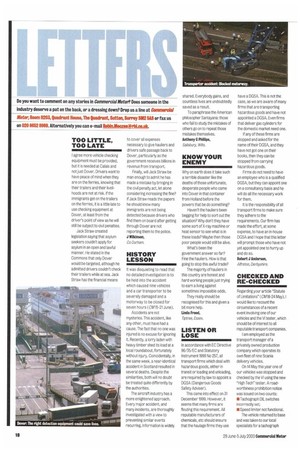CHECKED AND RE-CHECKED
Page 20

Page 21

If you've noticed an error in this article please click here to report it so we can fix it.
Regarding your article "Statute of limitations" (M18-24 May), I would like to recount the circumstances of a recent event involving one of our vehicles and the VI tester, which should be of interest to all reputable transport companies.
I am employed as the transport manager of a privately owned production company which operates its own fleet of nine Scania delivery vehicles.
On 14 May this year one of our vehicles was stopped and checked by the VI using the new "High Tech" tester. A roadworthiness prohibition notice was issued on two counts: • Tachograph DIL switches incorrectly set; • Speed limiter not functional. The vehicle returned to base and was taken to our local specialists for a tachograph check. The unit was found to be accurate and recorded correctly. However, it was discovered that the incorrect 'K' factor and OIL settings had been written onto the calibration sticker and the calibration certificate. The company concerned admitted liability, attributing the mistake to a clerical error. They duly arranged to pay for all the subsequent remedial work and testing. The vehicle was then taken to have its speed limiter checked. The calibration was OK and no fault was found. it was then presented for a full test to remove the prohibition notice. During the test the vehicle exceeded the speed limit.
A subsequent investigation discovered worn wiring insulation behind the passenger side kick board panel, causing an intermittent fault. This was repaired, the unit was recafibrated and the vehicle was re-tested satisfactorily.
On occasions such as this it is very easy to point the finger of blame at owners, managers and drivers—and reputations—can quickly be ruined. We were proven to be blameless, however, I wonder how many vehicles are out there carrying "clerical errors" or potential electrical faults which might result in much more serious consequences?
We fully support the Vehicle Inspectorate's efforts to weed out the cowboys and tamperers, and obviously the innovative use of advanced equipment must help to achieve this. However, this type of equipment can only be accurate if its input is accurate. Surely if a prohibition notice is issued and then proven to be based on inaccuracies or caused by genuine mechanical/electrical faults or failures, the notice should be withdrawn from the record. Mark Williams, Telford.












































































































